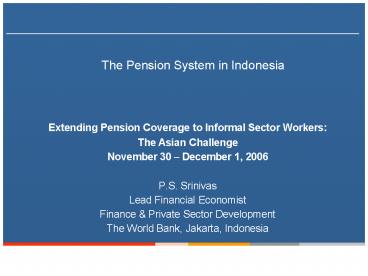The Pension System in Indonesia
1 / 15
Title:
The Pension System in Indonesia
Description:
... Private Sector Development. The World Bank, Jakarta, Indonesia ... Civil servants and armed forces systems will impose increasing fiscal costs in near future ... –
Number of Views:120
Avg rating:3.0/5.0
Title: The Pension System in Indonesia
1
The Pension System in Indonesia
- Extending Pension Coverage to Informal Sector
Workers - The Asian Challenge
- November 30 December 1, 2006
- P.S. Srinivas
- Lead Financial Economist
- Finance Private Sector Development
- The World Bank, Jakarta, Indonesia
2
Indonesias workforce is largely informal
Source Central Bureau of Statistics
3
and based in agriculture, trade, services
Source Central Bureau of Statistics
4
Indonesias population will age faster in the
next decades.
5
2000 Population Age Pyramid
6
2050 Population Age Pyramid -UN Projections
7
(No Transcript)
8
Summary of Pension Landscape (1)
- Current schemes focus on civil servants and
formal sector workers - No coverage for informal sector and self employed
- Targeted social safety net programs
- Commodity price subsidies and transfers
- Low coverage
- Population 220 million
- Total workforce 105 million
- Pension/provident funds - 18 million (15 of
work force) - Health insurance 17 million (public)
- lt 10 of population
- lt15 including private health insurance
- All mandatory social security institutions are
state owned enterprises - In principle all owned by Ministry of State Owned
Enterprises - Employer-based voluntary pension funds are
privately managed - In practice, fragmented system
- Different ministries operationally responsible
for different systems - Varying degrees of regulatory and supervisory
capacity - Poor coordination between ministries
- No overall idea of extent of contingent
liabilities imposed on state
9
Summary of Landscape (2)
- Governance
- Weak
- Overall, current system suffers from several
deficiencies - Does not provide a sound social safety net to the
vast majority of workers - Private sector system does not provide adequate
level of old-age benefits - Civil servants and armed forces systems will
impose increasing fiscal costs in near future - Does not encourage labor market flexibility
- Does not contribute to financial sector
strengthening
10
Recent Steps at Reform
- Objective Provide comprehensive social security
coverage to all Indonesians - Law enacted in October 2004
- Implementation just beginning
- In the long run, replace current programs
JAMSOSTEK, ASABRI, and TASPEN - Coverall workers formal, informal,
self-employed - Mandatory participation and contribution from
employers and employees - Includes social assistance scheme for poor
Indonesians - Governed by a tripartite board of government,
employers and workers - Day-to-day management (for now) to be in hands of
existing institutions - New institution to be created for informal
sector/self employed workers - No/limited role for private providers
- Defined benefit pension scheme
- Comprehensive health insurance program
11
Key Concerns
- Little recognition of extent of liabilities of
existing programs - Defined benefit program against prevalent
international practice - Demonstrated weaknesses in regulation and
supervision - No details on contributions/benefits structures
yet available - Consolidation of asset management with benefits
administration - No/limited opening to competition or outsourcing
- Role of sub-national governments not integrated
- Static normal retirement age
- Specifications left to implementing regulations
yet to be framed - Potential adverse labor market impact
- Reduction in employment and/or take-home pay
- Indonesia already suffers from weak investment
climate - No actuarial calculations to estimate
contributions/benefits relationship - No estimates of likely fiscal costs
12
Some illustrative estimates on impacts of the new
social security system
- Different sets of assumptions used on
- Demography (fertility rates, etc.)
- Retirement age
- Benefit levels
- Management performance (collection rates,
investment returns, administrative
costs/benefits, etc.) - Workforce
- Macroeconomic trends
13
(No Transcript)
14
Full Funding Asset Reserves as of GDP All
Scenarios
15
(No Transcript)































